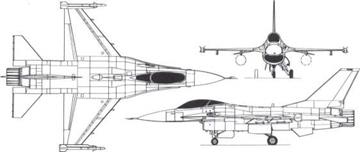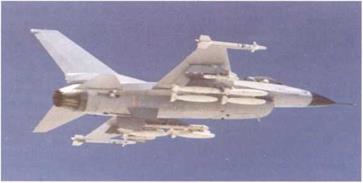General Dynamics F-16
Model 401, YF-16, F-16A, F-16B
Origin: General Dynamics/Fort Worth, USA, with widespread subcontract manufacture in Europe and European assembly of aircraft for European customers (see text).
Type: Single-seat fighter bomber; (B) operational trainer.
Engine: One 24.000lb (10,885kg) thrust Pratt & Whitney F100-PW-100 two-shaft afterburning turbofan.
Dimensions: Span (no Sidewinders) 31ft Oin (9-45m), (with Sidewinders) 32ft 10in (10 01m); length (excl probe) (YF-16) 46ft 6in, (F-16A) 47ft7-7in (14-52m); height (F-16) 16ft 5-2in (5 01m).
Weights: Empty (YF) about 12,0001b (5443kg); (F) about 14,8001b (6733kg); maximum gross (YF) 27,0001b (12,245kg); (F) 33,0001b (14,969kg).
Performance: Maximum speed, Mach 1 -95, equivalent to about 1,300mph (2090km/h); initial climb (YF) 40,000ft (12.200m)/min; service ceiling about 60,000ft (18,300m); range on internal fuel in interception mission, about 1.300 miles (2100km): attack radius at low level with maximum weapon load, 120 miles (193km); attack radius with six Mk 82 bombs, 339 miles (546km).
Armament: One 20mm M61 multi-barrel cannon on left side of fuselage; nine pylons for total external load of up to 15,2001b (6895kg) (YF, seven pylons for total of 11,500lb. 5217kg).
History: First flight (YF) 20 January 1974; service delivery, scheduled for mid-1 978.
Users: Belgium, Denmark, Israel, the Netherlands, Norway, US Air Force.
Development: One of the most important combat aircraft of the rest of the century was started merely as a technology demonstrator to see to what degree it would be possible to build a useful fighter that was significantly smaller and cheaper than the F-1 5. The US Air Force Lightweight Fighter (LWF) programme was not intended to lead to a production aircraft but merely to establish what was possible, at what cost. Contracts for two prototypes of each of the two best submissions were awarded in April 1972, the aircraft being the General Dynamics 401 and a simplified Northrop P.530. As the YF-16 and YF-17 these aircraft completed a programme of competitive evaluation, as planned, in 1974. By this time the wish of four European members of NATO – Belgium, Holland, Denmark and Norway – to replace their F-104Gs with an aircraft in this class had spurred a total revision of the LWF programme. In April 1974 it was changed into the Air Combat Fighter (ACF) programme and the Defense Secretary, James►
|
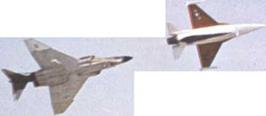
Above: This picture of an F-16 prototype tangling with an RF-4 Phantom emphasizes the contrast in sizes of these classic aircraft, both fighters’ which became multi-role platforms. As this book went to press there was no RF-16 dedicated recon type.
|
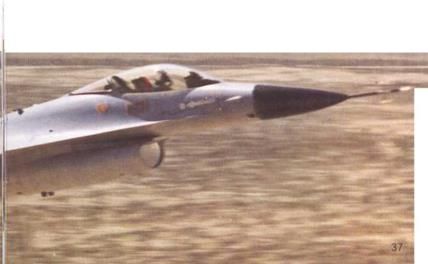
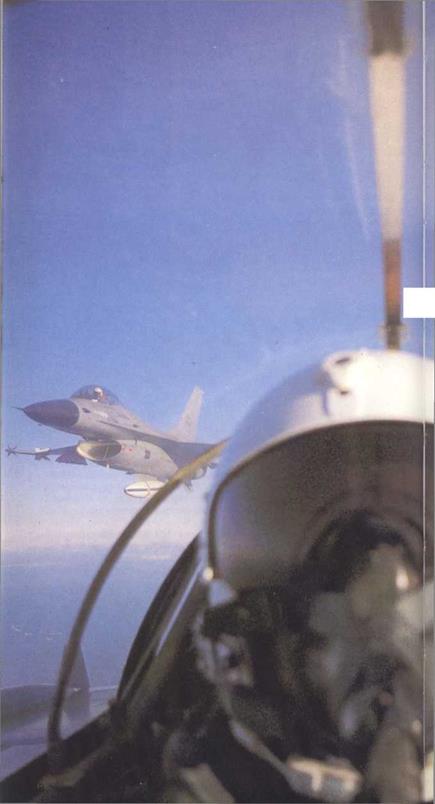
This splendid photograph, taken from the front seat of a TF-104G, shows (left) an F-16A with centreline tank and wingtip AIM-9L Advanced Sidewinder missiles, and (right) a two-seat F-16B with two 308-gal (1400 litre) underwing tanks and AIM-9J missiles on the tips. The photograph was secured in the summer of 1979 during multinational operations with the RNorAF in Norway.
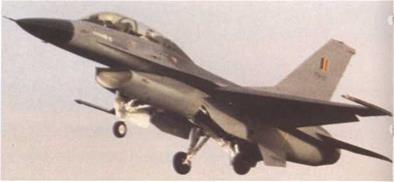 |
Schlesinger, announced that 650 of the winning design would be bought for the USAF, a number later raised to 1.388. In December 1974 the YF-16 was chosen as the future ACF (announced the following month) and in June 1975, after protracted and tortuous discussions, it was chosen by the four European countries. As an aircraft the F-16 is exciting. It has a flashing performance on the power of the single fully developed engine (the same as the F-15) fed by a simple fixed-geometry inlet. Structure and systems are modern, with control-configured vehicle (CCV) flight dynamics, quad-redundant electrically signalled controls (fly-by-wire), graphite – epoxy structures and a flared wing/body shape. Pilot view is outstanding and he lies back in a reclining Escapac seat and flies the aircraft through a sidestick controller. In the nose is an advanced pulse-doppler radar suitable for attack or interception missions and armament can be carried for both roles, though the basic design was biased strongly in favour of air-to-air missions in good weather at close range. It remains to be seen to what degree the F-16 can be modified to make it a better ground attack, reconnaissance or all-weather interceptor aircraft. Main contractors include Westinghouse (radar), M arcon і – El I iott (HUD-sight and portions of flight – control system), Westinghouse and Delco (computers), Kaiser (radar and electro-optical display) and Singer-Kearfott (inertial system). In 1977 the USAF still intends to purchase 650 aircraft, mainly for use in Europe; in 1976 it set up a European System Programme Office to manage the project.
Above; Takeoff of the first Belgian F-16B assembled by SABCA. Below: A grey-painted development (pre-production) F-16A.
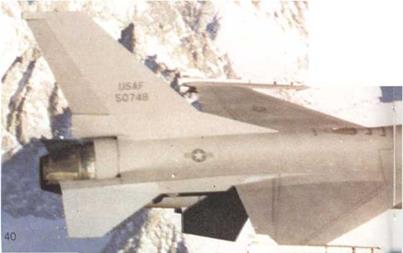 1 I
1 I
%
and began work on the support depot. Orders are still subject to change, but the planned totals are: Belgium, 90 F-16A and 12 F-16B, with 14 aircraft on option; Denmark 48 (probably 40+8). and 10 on option; the Netherlands, 84, plus 18 on option; Norway, 72 (no options). In July 1976 General Dynamics finally signed co-production contracts with major companies in Belgium and Holland, specifying schedules and output rates, of parts for 564 aircraft, a total that would increase with further F-16 sales. Aircraft will be assembled by General Dynamics (USAF), Fairey/SABCA (Belgium and Denmark) and Fokker-VFW (Netherlands and Norway); Kongsberg in Norway has a $1 63m co-production deal with Pratt & Whitney on more than 400 engines (all engines will be assembled by P & WA). Since early 1976 Turkey has been negotiating to join the European consortium (which has no formal title) and to buy up to 100 aircraft. In September 1976 Congress announced the sale to Iran of 160, costing $3-8 billion; it is doubtful that Iran can participate in manufacture. In December 1976 the first of eight development aircraft flew at Fort Worth, and delivery to the USAF is to begin in August 1978. Up to October 1976 $286 million had paid for basic development and flight test; Fiscal Year 1977 voted $620 million for the first 16 production aircraft, and FY78 is expected to provide $1,128 million. USAF buy in the next four years (1978-81) is planned to be 89, 145. 175 and 180, a total to that date of 605. First flight in Europe is planned to be at Schiphol (Fokker-VFW, Amsterdam) in July 1 979.
|
|
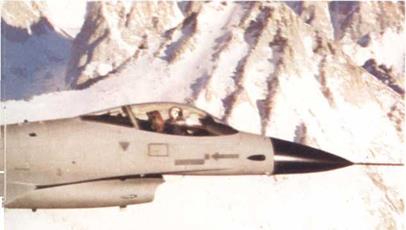
Above: An F-16A development aircraft (curiously, without tail number visible) with nose-mounted instrumentation and tandem triple-ejector racks each carrying two pairs of bombs only.











